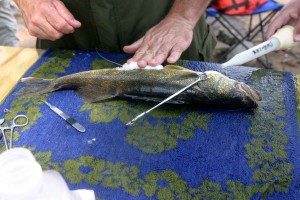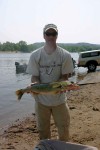Official: ‘Misperception’ to blame for proposed suit over fish habitat
RIVERSIDE — A dozen Inland Empire water agencies poised to wage a legal battle against the Obama administration over its decision to expand the habitat of an endangered fish may be laboring under a “misperception” about the impact of the edict, a federal official said Friday.
The Riverside County Flood Control & Water Conservation District, Riverside Public Utilities and 10 other agencies are threatening to file a lawsuit to stop the U.S. Fish & Wildlife Service from enlarging protected space for the Santa Ana Sucker.
According to the plaintiffs, a December ruling by federal officials would effectively shut off 125,800-acre-feet of water, depriving the region of one-third of its current fresh water stocks.
Representatives from the water agencies will be taking their complaints to members of the California congressional delegation on Monday.
According to USFWS spokeswoman Jane Hendron, the utilities are making a federal case out of a dispute based largely on superficialities, not actual harm.
Hendron said the “critical habitat” designation behind the controversy will not hinder use of water supplies.
“There’s a misperception about critical habitat. People don’t realize that it does not trigger any specific action,” Hendron told City News Service.
She said the designation provides an “additional layer of review” before developers or municipalities can proceed with making any changes along waterways that have been recognized as critical to a threatened species.
In the case of the Santa Ana Sucker, the U.S. Department of Interior’s “Final Rule” dictates that any planned modifications to the area encompassing the river’s headwaters in the San Bernardino Mountains be cleared by the USFWS or the U.S. Army Corps of Engineers.
The Sucker’s habitat has been further degraded by construction of the Seven Oaks Dam, which has “significantly altered the natural hydrological regime,” Hendron said. “This does affect habitat downstream. What you do upstream can affect the downstream environment,” she said. According to the water agencies, efforts to preserve the Sucker have been successful, and the federal ruling threatens to destabilize the region. Federal officials issued findings in 2005 that concluded state and local conservation efforts to protect the Sucker were paying off. However, last year, USFWS representatives reversed course. Citing a 2004 study, they declared gravel and cobble substrate required for the endangered fish’s survival had been drastically reduced since dam construction. Federal officials want higher volumes of water released from the dam to uncover substrate, which promotes algae growth and spawning grounds. Last month, a fact-finding committee composed of local and federal officials determined that stronger flows produced by releasing dam water often had the opposite effect of what was intended, creating high levels of sediment and murky underwater conditions — negatives for the fish. Local water agencies argue that the amount of water to be restricted for the benefit of the amphibian could be used to replenish regional water stocks and help reduce the region’s dependence on water imports from the San Joaquin Delta, which is already under a federal pumping limit to protect the endangered Delta Smelt.
See the dozens of unique artificial fish habitat models, fish attractors and fish cover used at fishiding.com, the industry leader and only science based, man made and artificial fish habitat, proven to provide all fish with cover they prefer to prosper.


 Water conditions were degraded with a very low pH, no alkalinity, and both iron and aluminum contamination. This point-source pollution left the stream uninhabitable for brook trout and other aquatic life. Williams Run is currently listed on the Pennsylvania Department of Environmental Protection’s 303d List of Impaired Streams.
Water conditions were degraded with a very low pH, no alkalinity, and both iron and aluminum contamination. This point-source pollution left the stream uninhabitable for brook trout and other aquatic life. Williams Run is currently listed on the Pennsylvania Department of Environmental Protection’s 303d List of Impaired Streams.




